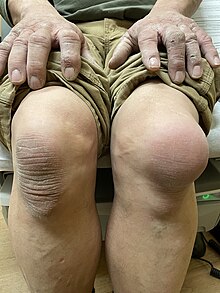Prepatellar bursitis
| Prepatellar bursitis | |
|---|---|
| Other names | beat knee,[1] carpet layer's knee, coal miner's knee, housemaid's knee,[2] rug cutter's knee, nun's knee[3] |
 | |
| Aseptic prepatellar bursitis | |
| Specialty | Orthopedic surgery, sports medicine, physical medicine and rehabilitation |
Prepatellar bursitis is an inflammation of the prepatellar bursa at the front of the knee. It is marked by swelling at the knee, which can be tender to the touch and which generally does not restrict the knee's range of motion. It can be extremely painful and disabling as long as the underlying condition persists.
Prepatellar bursitis is most commonly caused by
A definitive diagnosis can usually be made once a
Signs and symptoms

The primary symptom of prepatellar bursitis is swelling of the area around the kneecap. It generally does not produce a significant amount of pain unless pressure is applied directly.
Causes
In human
Prepatellar bursitis is caused by either a single instance of acute
The prepatellar bursa and the
Diagnosis

There are several types of inflammation that can cause knee pain, including sprains, bursitis, and injuries to the meniscus.[9] A diagnosis of prepatellar bursitis can be made based on a physical examination and the presence of risk factors in the person's medical history; swelling and tenderness at the front of the knee, combined with a profession that requires frequent kneeling, suggest prepatellar bursitis.[2] Swelling of multiple joints along with restricted range of motion may indicate arthritis instead.[5]: p. 608
A physical examination and medical history are generally not enough to distinguish between infectious and non-infectious bursitis;
Prevention
It is possible to prevent the onset of prepatellar bursitis, or prevent the symptoms from worsening, by avoiding trauma to the knee or frequent kneeling.
Treatment
Non-septic prepatellar bursitis can be treated with rest, the application of ice to the affected area, and
Opinions vary as to which treatment options are most effective for septic prepatellar bursitis.
Epidemiology
The various nicknames associated with prepatellar bursitis arise from the fact that it commonly occurs among those individuals whose professions require frequent kneeling, such as carpenters, carpet layers, gardeners, housemaids, mechanics, miners, plumbers, and roofers.[2][4][5]: p. 607 The exact incidence of the condition is not known; it is difficult to estimate because only severe septic cases require hospital admission, and mild non-septic cases generally go unreported.[5]: p. 607 Prepatellar bursitis is more common among males than females. It affects all age groups, but is more likely to be septic when it occurs in children.[18]
References
- ^ PMID 3447109.
- ^ ISBN 9780781745864.
- ^ "2012 ICD-9-CM Diagnosis Code 727.2 : Specific bursitides often of occupational origin".
- ^ ISBN 9780387356648.
- ^ PMID 3074561.
- ^ S2CID 42187890.
- ^ PMID 18672851.
- PMID 22623812.
- ^ ISSN 0092-8682.
- ISSN 0092-8682.
- ^ a b Shiel, William C. "Bursitis of the Knee". MedicineNet. Retrieved 9 May 2012.
- ^ PMID 2203571.
- ^ a b "Prepatellar (Kneecap) Bursitis". American Academy of Orthopaedic Surgeons. July 2007. Retrieved 10 May 2012.
- S2CID 45164840.
- PMID 8638508.
- PMID 2627225.
- PMID 20521045.
- ^ Allen, Kelly L (18 January 2012). "Prepatellar Bursitis". WebMD. Retrieved 21 May 2012.
